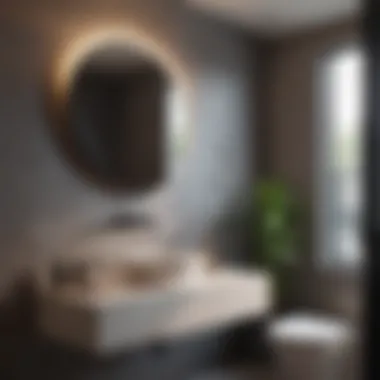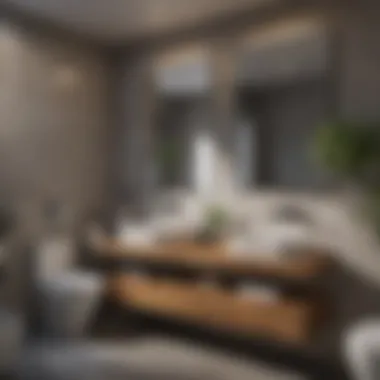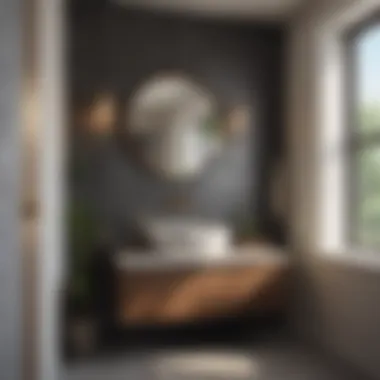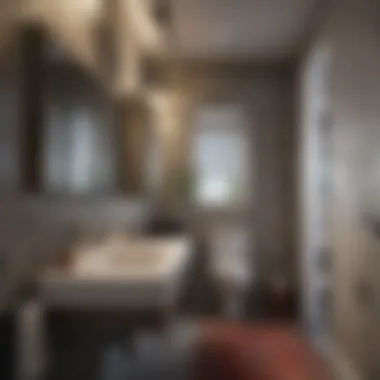Cost Breakdown for Building a Half Bathroom


Intro
Creating a half bathroom can seem like a great idea, especially for homeowners wishing to add convenience and comfort to their living spaces. However, diving into this project without considering all aspects can lead to financial pitfalls. Understanding costs isn't just about the money spent; it's about knowing where your hard-earned cash is going. From design concepts to labor costs and everything in between, each decision can significantly impact the overall budget.
This article aims to provide a comprehensive breakdown of the financial factors involved in establishing a half bathroom. We will explore current trends, ideal color palettes, and the respective costs associated with various choices. Homeowners will be better equipped to navigate this complex project by evaluating these elements.
Trending Styles
Modern Minimalism
The modern minimalist style resonates with simplicity and functionality. This style is characterized by clean lines, open spaces, and an uncluttered appearance. Homeowners opting for this design often find themselves paying for high-quality fixtures and materials that maintain this straightforward aesthetic.
- Fixtures: Choose wall-mounted sinks and compact toilets to save space.
- Materials: Try using materials that require less maintenance, such as quartz or solid surface counters, which can be costlier upfront but save long-term expenses.
Implementing a modern minimalist approach might look sleek, but don’t forget - the costs can add up quickly, so plan accordingly.
Cozy Rustic
On the other end of the spectrum is the cozy rustic style. This design embraces warmth and comfort, often using wood accents and earthy tones. It gives off that warm, homey feel. When considering a cozy rustic vibe, factors like reclaimed wood or handcrafted tiles can add both beauty and a hefty price tag.
- Materials: Opting for natural stone and light-colored woods can create a lasting impression.
- Details: Intricate designs on fixtures or artisanal sinks can elevate the space and increase total costs.
While creating this rustic charm, it’s essential to keep an eye on the expenses and determine what fits your budget without sacrificing the desired aesthetic.
Color Palettes
Calming Neutrals
Color choice significantly affects perceived space and mood. Calming neutrals like beige, gray, and white can create a serene atmosphere. These colors generally reflect light well, making small spaces feel more open.
- Labor Costs: Hiring professionals for painting may add to budgets, but the finish will likely look more polished.
- Durability: Consider the long-term durability of paint. Higher quality paints might come at a steeper initial price but won’t need to be redone as often.
Bold Accents
If you’re looking for something that pops, incorporating bold accents can deliver that. Colors like deep blues or vibrant greens can transform an ordinary half bathroom into a memorable space. However, it's important to remember that trendy colors can impact resale value positively or negatively, depending on buyer preferences.
- Accents: Consider statement walls or colorful fixtures like sinks or faucets, but keep in mind that these may cost more.
- Market Impact: Bold colors might be enjoyed now but could be a turn-off for future buyers.
In summary, whether your goal is modern minimalism with its sleek fixtures or the inviting warmth of a rustic style, both offer unique experiences and financial implications. With a focus on color palettes and style choices, you'll be better prepared to handle costs effectively.
"Choosing style over function can lead to regrettable decisions, especially when it comes to costs. Always balance your aesthetics with prices."
By understanding the nuances of design choices and their costs, homeowners can embark confidently on building their ideal half bathroom.
Prelude to Half Bathrooms
Creating an extra half bathroom in your home isn’t just a simple addition. It can be a strategic step that offers both convenience and financial benefits. The introduction of a half bathroom typically refers to a space that includes a toilet and a sink, but omits a shower or bathtub. This setup can serve numerous purposes, making it particularly appealing to homeowners.
By understanding the role of half bathrooms in residential settings, one can grasp their significance in the bigger picture of home design and utility. Particularly in family homes, having an additional bathroom can ease morning routines and improve privacy for guests.
Definition and Purpose
At the heart of it, a half bathroom addresses some common challenges many households face. These spaces primarily serve for quick use, freeing up time and alleviating some stress during those busy hours when multiple people need access to bathroom facilities. This can be a lifesaver during family events or simply getting everyone out the door in the morning.
A half bathroom can also be touted as a valuable asset when considering property valuations. Buyers often find homes with extra restrooms more attractive, enhancing marketability.
Benefits of Adding a Half Bathroom
When digging deeper into the advantages of adding a half bathroom, the benefits start to pile up:
- Increased Home Value: A half bathroom can elevate your home's appraised value, making it more attractive to prospective buyers. Real estate trends indicate that homes with at least two bathrooms often fetch higher prices.
- Convenience for Guests: Having a dedicated space for guests reduces the foot traffic in personal bathrooms, allowing for a more comfortable stay. This setup is often appreciated during family gatherings or parties.
- Enhanced Privacy: In a household with multiple individuals, an extra bathroom can significantly enhance privacy. When everyone is trying to juggle morning routines, a half bath can ease the situation.
- Future-Proofing Your Home: As families grow, needs change. Adding a half bathroom today can address a potential issue tomorrow, providing fluidity in space utilization.
Ultimately, understanding the local housing market and the specific needs of homeowners can help illuminate the numerous benefits of including a half bath. With increasing urban development, these renovations have become a go-to choice for families striving for better space management and functionality.
The addition of a half bathroom is often considered a smart investment for both immediate convenience and long-term financial return.
Understanding Cost Factors
When diving into the creation of a half bathroom, it’s vital to grasp the underlying cost factors. This understanding acts as a compass, guiding homeowners through their decision-making process. With multiple elements influencing how much one might spend, recognizing these variables is essential for budget management and achieving desired outcomes.
Being aware of each contributing factor can prevent financial pitfalls. It sheds light on unexpected expenses that can arise if you aren’t prepared. Additionally, comprehending the nuances of cost factors aids in prioritizing what is most important in your renovation. Do you want to splurge on high-end fixtures or perhaps save a bit by opting for more modest materials?


Material Choices
Flooring Options
In a half bathroom, flooring choices significantly affect both the aesthetics and functionality. For instance, ceramic tiles are a popular choice due to their durability and ease of maintenance. Not only are they waterproof, but they also come in a vast array of designs, allowing homeowners to find styles that resonate with their preferences.
However, there’s a flip side to consider. While ceramic tiles may be affordable upfront, installation costs can add up quickly. Likewise, luxury vinyl tiles are making waves too—they’re typically less expensive and simpler to install, but they might not have the same longevity as ceramic.
Wall Treatments
When it comes to wall treatments for a half bathroom, the selection of materials affects everything from ambiance to maintenance. Paint is often the go-to, thanks to its low cost and the freedom it offers for color changes. It’s an easy fix, and you can do it yourself if you’re feeling handy.
On the other hand, wallpaper can add a touch of elegance but could become a costly endeavor due to the need for specialized application and potential upkeep. Water-resistant wall panels are another alternative, offering a sturdier option with less maintenance. Just remember that wall treatments play a crucial role in the overall vibe of the space, hence their importance in budgeting.
Fixtures and Fittings
When talking about fixtures and fittings, the devil is in the details. The sink, toilet, and even the faucet can range from economical to pricey, depending on the brand and design selected. Standard models get the job done without breaking the bank, while designer pieces can make a statement but may require a larger slice of your budget.
Unique features, like touchless faucets or dual-flush toilets, bring their own advantages, providing convenience and potentially water savings over time. But, just as with everything else in this arena, understanding your priorities and budget is necessary for making the best choices.
Labor Costs
Construction Labor
Construction labor is another hefty player in the half bathroom equation. Whether you decide to embark on a DIY journey or hire professionals, it’s vital to factor in labor costs. General contractors can be a source of convenience, managing everything from the design process through to final inspections. However, their expertise often comes with a premium price.
For those looking to cut corners, hiring on an as-needed basis might work. That said, juggling multiple workers can lead to miscommunication and scheduling headaches. It’s a double-edged sword, weighing the benefits of professional oversight against the desire for affordability.
Electricians
Electricians are indispensable in ensuring your half bathroom is both functional and safe. Whether it's installing lighting fixtures or wiring outlets, their work is often necessary. Notably, decent electricians generally charge high hourly rates, which can quickly add up during longer projects. It's crucial to have a clear idea of what electrical work is required before jumping in.
Caution is also key—lowering costs by handling electrical work yourself may lead to more trouble down the line. Issues could arise with code compliance or safety hazards, possibly negating any initial savings.
Plumbers
Every half bathroom needs a proficient plumber—there’s just no two ways about it. Plumbing is not only complicated; it’s also crucial for the functionality of the space. The cost can vary significantly based on local rates and the expected complexity of the work.
"> A good plumber can save you from potential disasters, ensuring all fittings are not only installed correctly but that they also adhere to local regulations."
When looking at bigger projects, like repositioning a toilet or adding new plumbing lines, the costs can skyrocket. One misplaced pipe can do havoc on your budget. Keeping an open dialogue with your plumber on their process and predictions for potential costs is essential.
Design Complexity
Simple vs. Elaborate Designs
The design complexity will certainly influence your budget. Simple designs tend to streamline costs, as they usually require fewer materials and less labor. A straightforward layout offers functionality without extra frills, making it easier on the wallet.
However, if you’re drawn to something more elaborate, be prepared for a substantial financial leap. The inclusion of features like decorative tiles, specialized sink shapes, or intricate light fixtures can look stunning but will naturally raise the stakes budget-wise.
The key is balancing aesthetic desires with financial reality.
Custom Features
Custom features are an opportunity for personalized touches that can elevate your half bathroom. Things like custom-built cabinets or tailored vanities make for unique spaces that reflect your personality. Though they can be worth their weight in gold when it comes to enhancing your enjoyment of the area, they can also push costs into a whole new ballpark. The more tailored and specific your wishes, the higher typically the upfront investment is.
A word of caution: while custom pieces can be beautiful, over-customization might make future renovations or resales complicated. Always weigh these considerations against the immediate benefits.
In summary, understanding these cost factors allows for an informed approach in budgeting for a half bathroom. By carefully considering material choices, labor costs, and design complexity, homeowners can make smart decisions that align their financial plans with their personal preferences.
Typical Cost Breakdown
Understanding the financial intricacies involved in establishing a half bathroom is vital for homeowners. A careful consideration of costs enables homeowners to allocate budgets effectively, ensuring that each aspect of the project aligns with their financial capabilities. This section delves into a structured approach to breaking down costs into manageable pieces.
Materials Overview
Cost of Flooring
Flooring is a cornerstone of a half bathroom’s aesthetic and functional appeal. The expense associated with flooring can vary widely, ranging from the luxurious feel of porcelain tiles to the river-stone allure of vinyl. Investing in quality flooring not only enhances visual appeal but also contributes to the durability of the bathroom. A particular advantage of ceramic tiles is their resistance to moisture and ease of cleaning. However, they can be a bit on the pricey side.
Some popular choices for flooring finish include:


- Ceramic tiles: Durable and aesthetically vast but might require a higher initial investment.
- Vinyl flooring: Cost-effective and easy to maintain, though it may not have the same lifespan as other materials.
- Laminate: Affordable and versatile but can struggle with moisture, leading to long-term issues.
The unique feature of flooring costs is the combination of material choice with installation expenses. While more affordable options might seem appealing at first glance, the long-term costs associated with maintenance and replacement must also be considered.
Cost of Plumbing Fixtures
Plumbing fixtures are the unsung heroes of half bathrooms, affecting both functionality and overall style. The cost of plumbing fixtures encompasses everything from sinks and faucets to toilets. A attractive fixture can elevate the entire area, making it worth the extra dough.
For example, a sleek pedestal sink can value add while providing efficient space usage. It’s important to note, though, that plumbing fixtures can be varied in price:
- Standard fixtures can often be found between average wholesale sources.
- Designer fixtures may drive expenses up substantially but often pay back with durability and resale appeal.
Choosing plumbing fixtures also entails looking ahead at the maintenance needs and replacement potential. The key characteristic here is how closely they align with your desired design aesthetic and practical needs, making elegance and functionality go hand in hand.
Cost of Lighting and Ventilation
Lighting and ventilation play significant roles, not only impacting the comfort of space but also its appearance. Bright, well-placed lights can transform a half bathroom from drab to fab, while proper ventilation wards off unwanted moisture and odors. The costs here largely depend on:
- Type of light fixtures: Recessed lights or stylish sconces? Each carries its own heft in terms of prices.
- Vent systems: Standard exhaust fans might be budget-friendly, but investing in models with better filtration can prove beneficial in the long run.
Understanding the unique visibility of lighting choices can vastly change daily experiences within the bathroom. An important consideration is how the cost of lighting can often reveal the difference between a simple necessity and a dazzling touch of elegance that one might be willing to invest in, heightening the overall aesthetic of the half bathroom space.
Labor Overview
Average Hourly Rates
Labor costs are an essential part of any renovation. The average hourly rates charged by skilled tradesmen, whether plumbers or electricians, can have a significant effect on the overall budget. Given the specialized skills required for plumbing and electrical work, these rates can be higher than one might expect, often influenced by geographic location.
Typically, the rates may be:
- Plumbers: Generally command a fee that reflects their expertise. Specialty fixtures might increase labor rate further.
- Electricians: Also tend to ask for a premium but are crucial to ensuring safety and compliance.
Knowing the average can help homeowners budget accurately and avoid any unpleasant surprises. Trust is crucial, so seeking out qualified professionals and understanding their pricing structures is key. Each region has its unique pricing landscape, making comparison shopping vital.
Projected Total Labor Costs
After understanding average rates, projecting total labor costs can solidify a budget. Estimating this effectively involves gauging the total number of hours needed for the job at hand. Different projects demand various levels of expertise. For instance, straightforward installations may happen quicker than elaborate designs requiring custom adjustments.
Expected expenses might look as follows:
- Simple installations: Could mean a lower total owing to less time spent.
- Complex projects: Potentially more time-consuming, likely leading to higher overall labor costs.
The essential feature of projecting total labor costs is understanding that they should always be considered alongside the quality of work provided. Choosing quality can ensure that the initial investment leads to fewer headaches down the road.
Regional Variations in Costs
The financial landscape of creating a half bathroom isn’t uniform; it varies widely depending on several factors, including location. Understanding regional variations in costs is crucial for homeowners looking to make informed decisions. Various elements come into play which can influence the overall expense of this home improvement project.
When we dive into the specifics, regional cost differences can affect material prices, labor rates, and even local regulations, all of which contribute to the total investment required. It's vital to grasp how these factors can alter the budgeting process as the old saying goes, "Location, location, location," rings especially true in construction and renovation projects.
Urban vs. Rural Areas
Cost Disparities
In urban areas, the costs associated with creating a half bathroom typically shoot through the roof, thanks to increased demand for services and materials. This demand impacts the pricing of everything from contractors to items like tiles and plumbing fixtures. Homes in cities like New York or San Francisco often see costs nearly double compared to similar projects in rural locations.
Conversely, rural areas may offer substantial savings. While the initial gripe may be about limited access to high-end materials, sourcing them is often cheaper owing to lower overhead costs. Homeowners in these locations can benefit significantly from these cost disparities, making additions less of a financial strain.
Accessibility to Skilled Labor
When considering accessibility to skilled labor, the landscape also showcases drastic differences between urban and rural settings. In a bustling city, you’d find plenty of contractors, electricians, and plumbers keen on snatching up the next gig. While this may seem advantageous, it ironically often leads to higher labor costs due to competition and demand.
On the flip side, in rural areas, there may be fewer professionals available, potentially causing delays in the project timeline. However, this relative scarcity may also result in more competitive pricing since contractors might be more eager to secure jobs. Homeowners must weigh the pros and cons carefully when considering where to embark on their renovation journey.
Local Building Regulations
Permitting Costs
Cost considerations aren’t only restricted to materials and labor; local building regulations play a pivotal role too. Permits necessary for renovations vary significantly by region, impacting the overall budget. In major urban centers, costs for permits can shoot up significantly. Bureaucratic red tape may require a homeowner to spend more time and money navigating the local authority’s demands compared to more straightforward regulations in rural locations.
Obtaining permits in cities can often take longer as well, meaning renovations may stretch beyond initial timelines. The obligation to comply with strict guidelines often leads homeowners to seek professional assistance, adding to overall expenses.


Compliance Expenses
Compliance expenses take this a step further. Depending on the location, several codes must be observed to ensure a half bathroom meets safety and health requirements. Urban areas often have rigorous standards, and failing to adhere can lead to costly fines. The knowledge of local codes can also necessitate hiring professionals, which further swells the budget.
In rural settings, compliance may be less stringent, but this doesn't mean the standards should be ignored. Issues arising from non-compliance can lead to greater costs later on, such as repairs or the need to redo work that didn't meet basic guidelines.
To wrap it up, navigating the regional variations in costs isn't merely about tallying up expenses. It’s about understanding the broader implications of location on financial commitments aimed at creating that half bathroom. Homeowners must take care to delve into specifics of their area, weigh their options wisely, and ensure that they are prepared for any potential hurdles before diving into the project.
Financing Options
When considering the addition of a half bathroom, understanding your financing options is a crucial step in the planning process. This section focuses on various ways to fund your renovation project, the pros and cons of each method, and how these choices can impact your financial health. Whether you have some savings tucked away, plan on taking out loans, or consider tapping into your home equity, knowing all these options helps shape your decisions and can avert potential money woes down the line.
Personal Savings vs. Loans
Diving into your personal savings might seem like the most straightforward approach. If you’ve been saving up, using your own funds can let you avoid the tangled web of interest rates and repayment schedules that come with loans. This method also encourages a disciplined approach to spending, allowing you to ensure that you’re financially ready to tackle the project without the burden of future debts. However, depending on your financial situation, this may not cover all costs. Sometimes, it means cutting corners or delaying the project.
On the flip side, loans are often essential for larger expenses. A personal loan or a home renovation loan can provide the necessary capital to bring your vision to life. However, it's not a decision to be taken lightly. With loans, you need to account for interest rates and repayment timelines, which could stretch out for years. It’s advisable to compare different lenders and loan types to find one that best matches your financial capability without overextending yourself.
Home Equity Financing
Home equity financing involves borrowing against the value of your home. This can be an appealing option due to generally lower interest rates compared to personal loans. Here’s what you need to know about it.
Understanding Equity
Equity is essentially the part of your home that you own outright. It’s calculated by taking the current value of your property and subtracting any outstanding mortgage balances. For many homeowners, equity builds over time through rising property values and regular mortgage payments. Accessing this equity can be a compelling choice for funding a half bathroom renovation, especially if you’ve built up a substantial amount. The key characteristic of home equity financing is that it allows you to utilize the wealth stored in your home while retaining ownership, making it a popular choice when considering renovations umcie diagnosing good. However, it is vital to consider that by borrowing against your home, you are taking on additional risk if your financial situation changes.
Potential Risks
With potential rewards come potential risks. Borrowing against your home can be a double-edged sword. One of the main risks is the chance of property value fluctuations. If the market dips, you could end up owing more than your home is worth, leading to financial strain. Moreover, you should be aware that home equity loans often come with closing costs, similar to traditional mortgages. The unique trait of this financing route is that failure to repay can lead to foreclosure, a consequence that is dire. Therefore, it’s critical to assess your budget, stable income, and future plans.
In summary: While home equity financing can be advantageous for funding a bathroom renovation, it does come with significant risks that require careful consideration before proceeding.
Potential Return on Investment
When thinking about adding a half bathroom, one of the most pressing concerns for homeowners is the potential return on investment (ROI) that this renovation can provide. Understanding this aspect is crucial because it helps homeowners not just think about immediate costs but long-term benefits too. Let's unpack the components that contribute to ROI when creating a small bathroom.
Market Value Increase
Investing in a half bathroom can significantly boost a home's market value. Let's say you're contemplating a new addition. In a tight market where homes compete for buyers’ eyes, an extra bathroom can easily set your property apart.
- Comparative Value: If similar homes in your neighborhood have two full bathrooms, adding a half bath allows you to match that standard, making your property more attractive.
- Appeal to Families: More bathrooms mean less morning chaos! Families appreciate having multiple spaces, and this amenity can justify a higher listing price when it comes time to sell.
- Local Market Trends: Depending on your area, homes with additional bathrooms often sell faster. According to local real estate statistics, houses can garner up to 20% more in sales just by adding a bath.
“A half bathroom is not just an upgrade; it’s a strategic enhancement that may pay dividends in the long haul.”
By considering these factors, you can clearly see how the value of your home can rise after the installation of a half bathroom. It’s not merely about the present; it’s about future advantages.
Attractiveness to Buyers
Another significant reason to consider a half bathroom renovation is its impact on a property's appeal to potential buyers. In today's real estate landscape, very few buyers want to settle for a home where they have to share one bathroom among multiple people. A half bath acts like a cherry on top, making your home far more marketable.
- Convenience Factor: Buyers often see a half bathroom as a solution to everyday inconveniences. With a dedicated space for guests, it allows better traffic flow within the home.
- Perceived Luxury: Adding a half bathroom conveys a sense of luxury and modernity. Prospective homeowners may be more willing to pay a premium for a house that offers this added comfort.
- Versatility: It can serve multiple purposes—be it a powder room for guests or a modest space for kids doing their morning rituals. This versatility greatly enhances its desirability.
In short, a half bathroom could very well turn heads in a crowded housing market, generating more interest amongst buyers interested in a home that ticks all the right boxes.
Understanding both the market value increase and the attractiveness to buyers provides a clear picture of how investing in a half bathroom can yield substantial returns, making it a smart decision for homeowners looking to enhance their property.
Finale
Creating a half bathroom can seem like a monumental task, but it holds considerable merit for homeowners willing to tackle it. The importance of this section lies in summarizing the multifaceted factors involved in the cost analysis process. Not only does understanding these aspects empower you with knowledge, but it also keeps you from getting lost in the weeds when it comes to budgeting.
Budgeting for a half bathroom goes beyond simply adding up cash to your pocket. It involves dissection of costs that may not be immediately clear, such as permits, labor, and the type of materials you choose. Each of these can have a substantial impact on the final cost. A well-informed homeowner can navigate these intricacies more effortlessly, ensuring that the necessary financial commitments are acceptable and reasonable.
The long-term benefits, such as potential increases in property value and enhanced livability, also deserve mention. As you finalize decisions, remember that every little detail counts, from the aesthetic appeal of the fixtures to the allure for potential buyers in the future.
"When you know the costs, you can make better choices. It’s all in the planning!"
Recap of Key Points
To make it easier for you to digest this treasure trove of information, let’s recap the vital points you should remember:
- Material Choices: Different materials come with different prices. Whether it’s flooring or fixtures, pick what fits not just the budget, but your long-term vision.
- Labor Costs: Hiring skilled labor can save you both time and money in the long run. Consider the balance between cost and expertise.
- Design Complexity: A simple design may suffice, but custom features can provide you uniqueness, albeit at an additional cost.
- Regional Variations: Not all areas are created equal. Cost can vary significantly, influenced by local labor rates and regulations.
- Financing Options: Understand your financing methods, from personal savings to home equity loans. Every option has its pros and cons.
Final Considerations for Homeowners
Before taking the leap to create a half bathroom, several final considerations come to mind:
- Assess Your Needs: Think about why you're adding a half bathroom. Is it for personal convenience, or are you trying to increase your home's marketability?
- Establish a Realistic Budget: Don't just scratch the surface. Dig deep to include all potential expenses to avoid surprises down the line.
- Timing Matters: When to start your project can be just as important as how to do it. Choosing the right time might save you money.
- Consult Professionals: Don't hesitate to bring in architects or contractors to ensure you’re on the right path. Their expertise can help smooth over complicated processes.
- Plan for the Unexpected: Things happen. Be ready for a few bumps along the way, both in time and costs.
Ultimately, approaching the decision to create a half bathroom with careful thought and planning can lead to success, not just in terms of financial investment but also in enhancing your living space for years to come.















